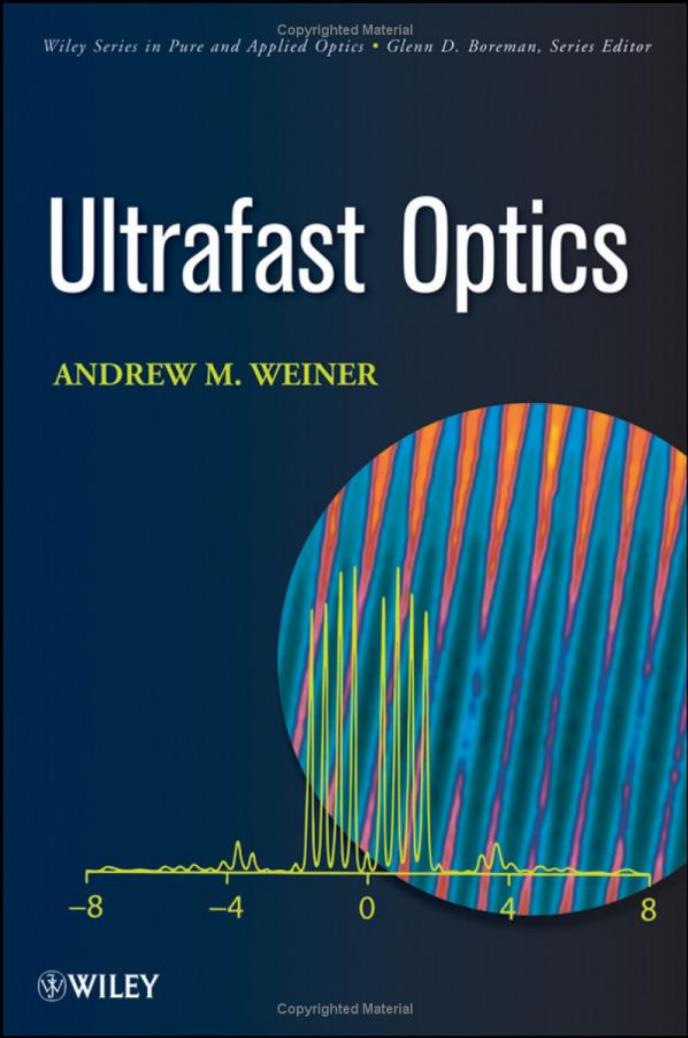
Copyrighted Material Wiley Series in Pure and Applied Opties.Glenn D.Boreman.Series Editor Ultrafast Optics ANDREW M.WEINER -8 0 ③WILEY Copyrighted Material
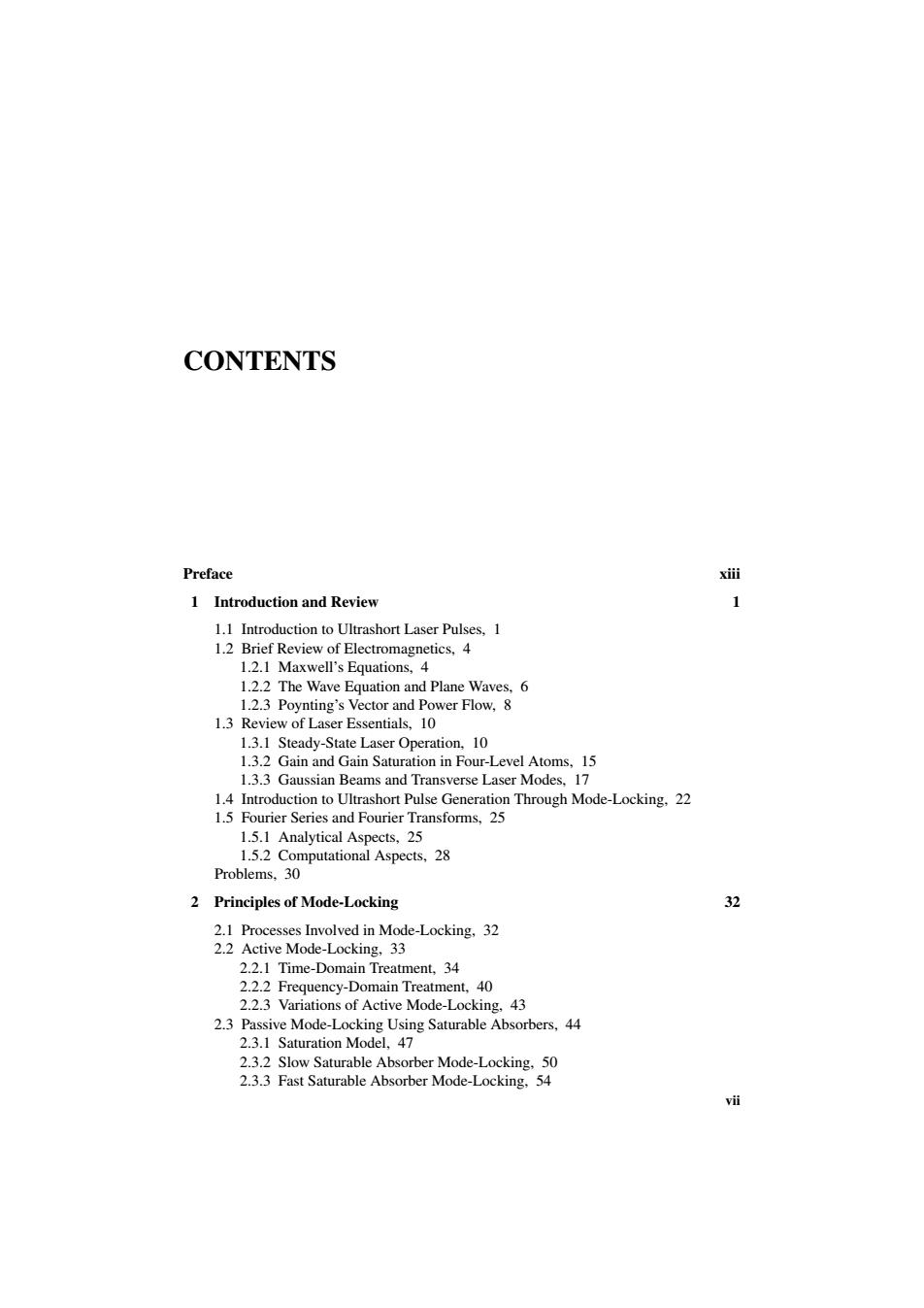
CONTENTS Preface xii 1 Introduction and Review 1.1 Introduction to Ultrashort Laser Pulses,1 1.2 Brief Review of Electromagnetics,4 1.2.1 Maxwell's Equations,4 1.2.2 The Wave Equation and Plane Waves,6 1.2.3 Poynting's Vector and Power Flow,8 1.3 Review of Laser Essentials,10 1.3.1 Steady-State Laser Operation,10 1.3.2 Gain and Gain Saturation in Four-Level Atoms,15 1.3.3 Gaussian Beams and Transverse Laser Modes,17 1.4 Introduction to Ultrashort Pulse Generation Through Mode-Locking.22 1.5 Fourier Series and Fourier Transforms,25 1.5.1 Analytical Aspects,25 1.5.2 Computational Aspects,28 Problems.30 2 Principles of Mode-Locking 32 2.1 Processes Involved in Mode-Locking,32 2.2 Active Mode-Locking,33 2.2.1 Time-Domain Treatment,34 2.2.2 Frequency-Domain Treatment,40 2.2.3 Variations of Active Mode-Locking.43 2.3 Passive Mode-Locking Using Saturable Absorbers,44 2.3.1 Saturation Model,47 2.3.2 Slow Saturable Absorber Mode-Locking,50 2.3.3 Fast Saturable Absorber Mode-Locking,54 vii
CONTENTS Preface xiii 1 Introduction and Review 1 1.1 Introduction to Ultrashort Laser Pulses, 1 1.2 Brief Review of Electromagnetics, 4 1.2.1 Maxwell’s Equations, 4 1.2.2 The Wave Equation and Plane Waves, 6 1.2.3 Poynting’s Vector and Power Flow, 8 1.3 Review of Laser Essentials, 10 1.3.1 Steady-State Laser Operation, 10 1.3.2 Gain and Gain Saturation in Four-Level Atoms, 15 1.3.3 Gaussian Beams and Transverse Laser Modes, 17 1.4 Introduction to Ultrashort Pulse Generation Through Mode-Locking, 22 1.5 Fourier Series and Fourier Transforms, 25 1.5.1 Analytical Aspects, 25 1.5.2 Computational Aspects, 28 Problems, 30 2 Principles of Mode-Locking 32 2.1 Processes Involved in Mode-Locking, 32 2.2 Active Mode-Locking, 33 2.2.1 Time-Domain Treatment, 34 2.2.2 Frequency-Domain Treatment, 40 2.2.3 Variations of Active Mode-Locking, 43 2.3 Passive Mode-Locking Using Saturable Absorbers, 44 2.3.1 Saturation Model, 47 2.3.2 Slow Saturable Absorber Mode-Locking, 50 2.3.3 Fast Saturable Absorber Mode-Locking, 54 vii
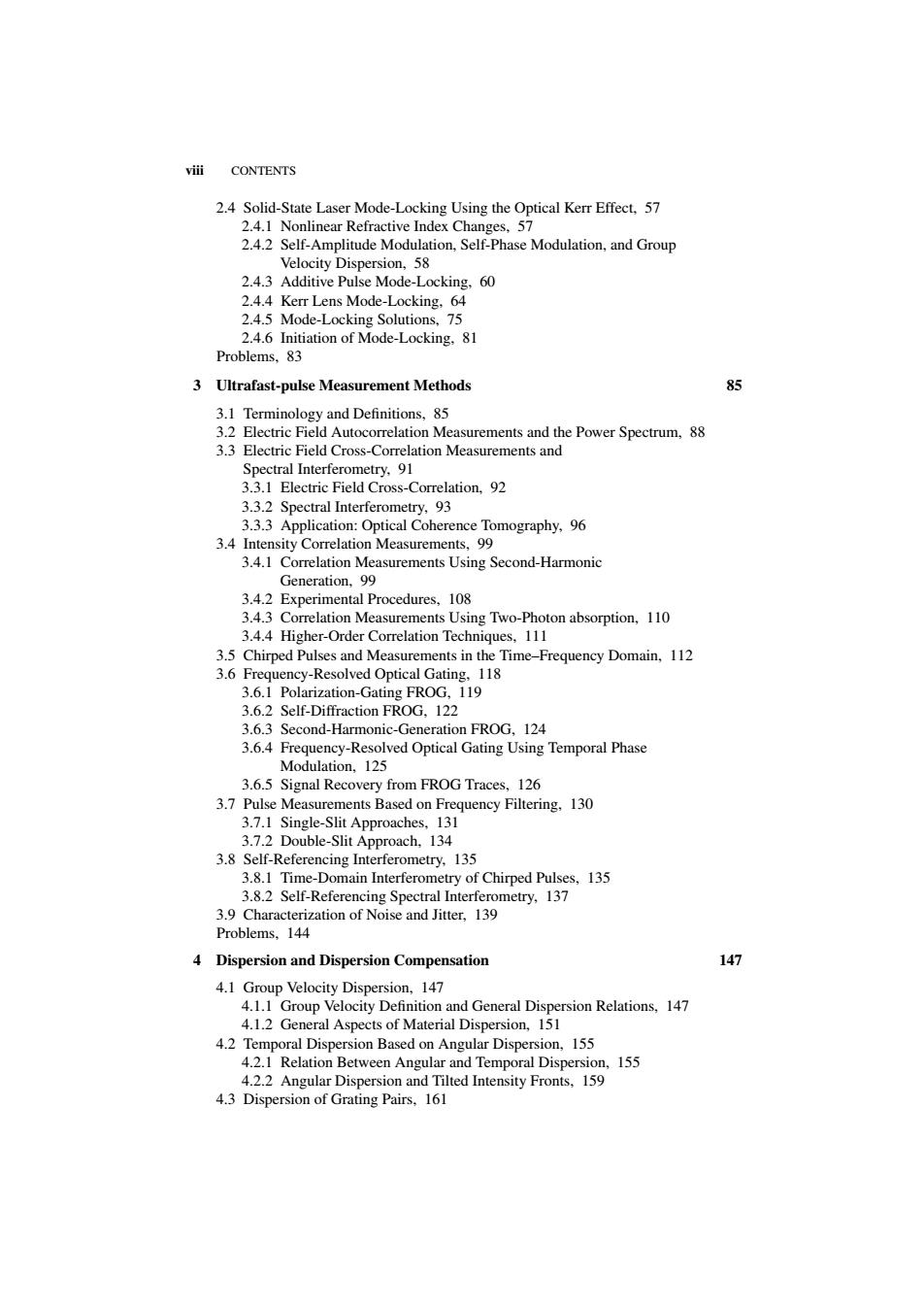
viii CONTENTS 2.4 Solid-State Laser Mode-Locking Using the Optical Kerr Effect,57 2.4.1 Nonlinear Refractive Index Changes,57 2.4.2 Self-Amplitude Modulation,Self-Phase Modulation,and Group Velocity Dispersion,58 2.4.3 Additive Pulse Mode-Locking,60 2.4.4 Kerr Lens Mode-Locking,64 2.4.5 Mode-Locking Solutions,75 2.4.6 Initiation of Mode-Locking,81 Problems,83 3 Ultrafast-pulse Measurement Methods 85 3.1 Terminology and Definitions,85 3.2 Electric Field Autocorrelation Measurements and the Power Spectrum,88 3.3 Electric Field Cross-Correlation Measurements and Spectral Interferometry,91 3.3.1 Electric Field Cross-Correlation.92 3.3.2 Spectral Interferometry,93 3.3.3 Application:Optical Coherence Tomography,96 3.4 Intensity Correlation Measurements,99 3.4.1 Correlation Measurements Using Second-Harmonic Generation,99 3.4.2 Experimental Procedures,108 3.4.3 Correlation Measurements Using Two-Photon absorption,110 3.4.4 Higher-Order Correlation Techniques,111 3.5 Chirped Pulses and Measurements in the Time-Frequency Domain,112 3.6 Frequency-Resolved Optical Gating,118 3.6.1 Polarization-Gating FROG.119 3.6.2 Self-Diffraction FROG.122 3.6.3 Second-Harmonic-Generation FROG,124 3.6.4 Frequency-Resolved Optical Gating Using Temporal Phase Modulation,125 3.6.5 Signal Recovery from FROG Traces,126 3.7 Pulse Measurements Based on Frequency Filtering.130 3.7.1 Single-Slit Approaches,131 3.7.2 Double-Slit Approach,134 3.8 Self-Referencing Interferometry,135 3.8.1 Time-Domain Interferometry of Chirped Pulses,135 3.8.2 Self-Referencing Spectral Interferometry,137 3.9 Characterization of Noise and Jitter,139 Problems,144 4 Dispersion and Dispersion Compensation 147 4.1 Group Velocity Dispersion,147 4.1.1 Group Velocity Definition and General Dispersion Relations,147 4.1.2 General Aspects of Material Dispersion,151 4.2 Temporal Dispersion Based on Angular Dispersion,155 4.2.1 Relation Between Angular and Temporal Dispersion,155 4.2.2 Angular Dispersion and Tilted Intensity Fronts,159 4.3 Dispersion of Grating Pairs,161
viii CONTENTS 2.4 Solid-State Laser Mode-Locking Using the Optical Kerr Effect, 57 2.4.1 Nonlinear Refractive Index Changes, 57 2.4.2 Self-Amplitude Modulation, Self-Phase Modulation, and Group Velocity Dispersion, 58 2.4.3 Additive Pulse Mode-Locking, 60 2.4.4 Kerr Lens Mode-Locking, 64 2.4.5 Mode-Locking Solutions, 75 2.4.6 Initiation of Mode-Locking, 81 Problems, 83 3 Ultrafast-pulse Measurement Methods 85 3.1 Terminology and Definitions, 85 3.2 Electric Field Autocorrelation Measurements and the Power Spectrum, 88 3.3 Electric Field Cross-Correlation Measurements and Spectral Interferometry, 91 3.3.1 Electric Field Cross-Correlation, 92 3.3.2 Spectral Interferometry, 93 3.3.3 Application: Optical Coherence Tomography, 96 3.4 Intensity Correlation Measurements, 99 3.4.1 Correlation Measurements Using Second-Harmonic Generation, 99 3.4.2 Experimental Procedures, 108 3.4.3 Correlation Measurements Using Two-Photon absorption, 110 3.4.4 Higher-Order Correlation Techniques, 111 3.5 Chirped Pulses and Measurements in the Time–Frequency Domain, 112 3.6 Frequency-Resolved Optical Gating, 118 3.6.1 Polarization-Gating FROG, 119 3.6.2 Self-Diffraction FROG, 122 3.6.3 Second-Harmonic-Generation FROG, 124 3.6.4 Frequency-Resolved Optical Gating Using Temporal Phase Modulation, 125 3.6.5 Signal Recovery from FROG Traces, 126 3.7 Pulse Measurements Based on Frequency Filtering, 130 3.7.1 Single-Slit Approaches, 131 3.7.2 Double-Slit Approach, 134 3.8 Self-Referencing Interferometry, 135 3.8.1 Time-Domain Interferometry of Chirped Pulses, 135 3.8.2 Self-Referencing Spectral Interferometry, 137 3.9 Characterization of Noise and Jitter, 139 Problems, 144 4 Dispersion and Dispersion Compensation 147 4.1 Group Velocity Dispersion, 147 4.1.1 Group Velocity Definition and General Dispersion Relations, 147 4.1.2 General Aspects of Material Dispersion, 151 4.2 Temporal Dispersion Based on Angular Dispersion, 155 4.2.1 Relation Between Angular and Temporal Dispersion, 155 4.2.2 Angular Dispersion and Tilted Intensity Fronts, 159 4.3 Dispersion of Grating Pairs, 161
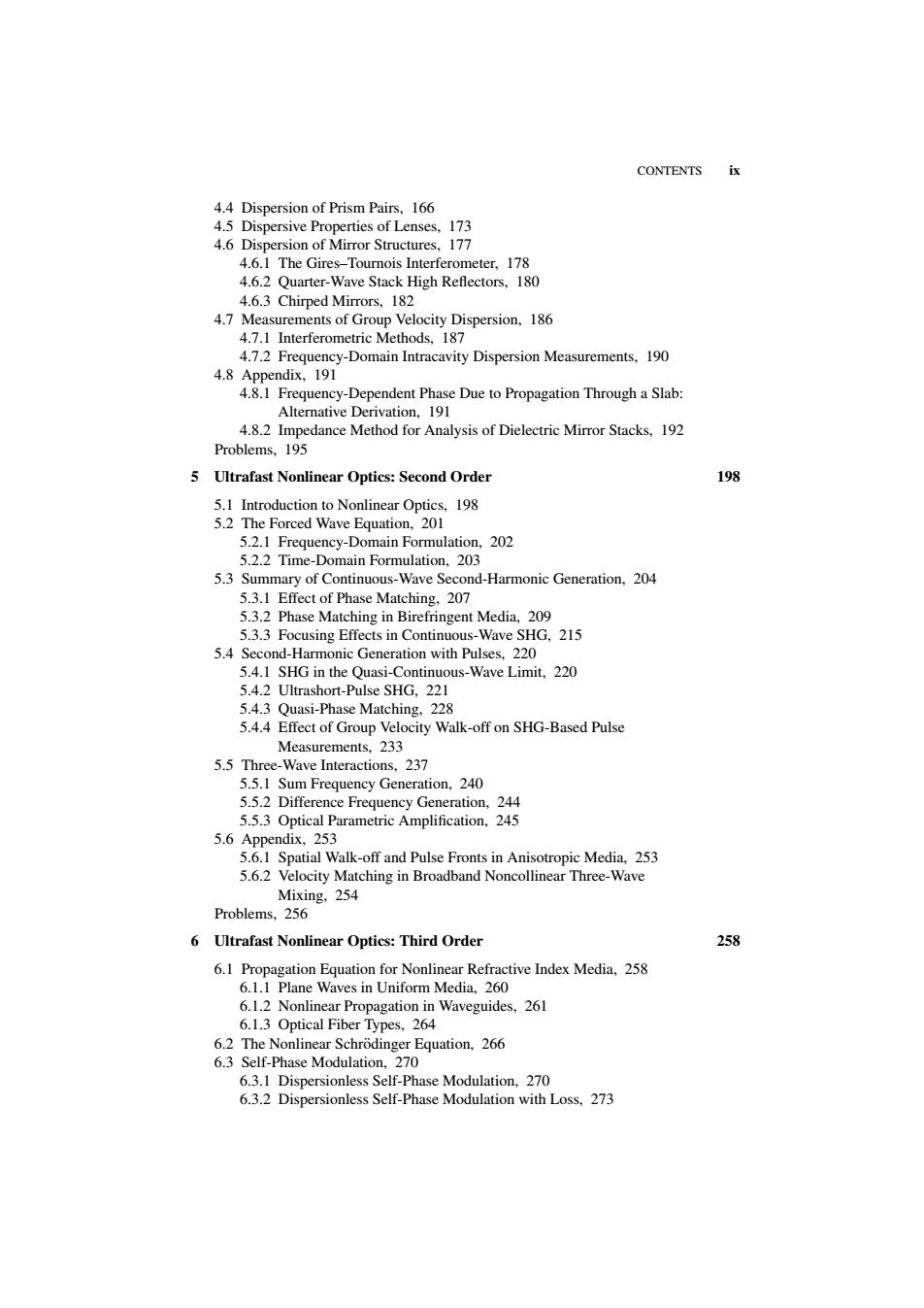
CONTENTS 年 4.4 Dispersion of Prism Pairs,166 4.5 Dispersive Properties of Lenses.173 4.6 Dispersion of Mirror Structures,177 4.6.1 The Gires-Tournois Interferometer,178 4.6.2 Quarter-Wave Stack High Reflectors,180 4.6.3 Chirped Mirrors,182 4.7 Measurements of Group Velocity Dispersion,186 4.7.1 Interferometric Methods,187 4.7.2 Frequency-Domain Intracavity Dispersion Measurements,190 4.8 Appendix,191 4.8.1 Frequency-Dependent Phase Due to Propagation Through a Slab: Alternative Derivation,191 4.8.2 Impedance Method for Analysis of Dielectric Mirror Stacks,192 Problems,195 5 Ultrafast Nonlinear Optics:Second Order 198 5.1 Introduction to Nonlinear Optics,198 5.2 The Forced Wave Equation,201 5.2.1 Frequency-Domain Formulation,202 5.2.2 Time-Domain Formulation,203 5.3 Summary of Continuous-Wave Second-Harmonic Generation,204 5.3.1 Effect of Phase Matching,207 5.3.2 Phase Matching in Birefringent Media,209 5.3.3 Focusing Effects in Continuous-Wave SHG,215 5.4 Second-Harmonic Generation with Pulses,220 5.4.1 SHG in the Quasi-Continuous-Wave Limit,220 5.4.2 Ultrashort-Pulse SHG,221 5.4.3 Quasi-Phase Matching,228 5.4.4 Effect of Group Velocity Walk-off on SHG-Based Pulse Measurements.233 5.5 Three-Wave Interactions,237 5.5.1 Sum Frequency Generation,240 5.5.2 Difference Frequency Generation,244 5.5.3 Optical Parametric Amplification,245 5.6 Appendix,253 5.6.1 Spatial Walk-off and Pulse Fronts in Anisotropic Media,253 5.6.2 Velocity Matching in Broadband Noncollinear Three-Wave Mixing,254 Problems,256 6 Ultrafast Nonlinear Optics:Third Order 258 6.1 Propagation Equation for Nonlinear Refractive Index Media,258 6.1.1 Plane Waves in Uniform Media,260 6.1.2 Nonlinear Propagation in Waveguides,261 6.1.3 Optical Fiber Types,264 6.2 The Nonlinear Schrodinger Equation,266 6.3 Self-Phase Modulation,270 6.3.1 Dispersionless Self-Phase Modulation,270 6.3.2 Dispersionless Self-Phase Modulation with Loss,273
CONTENTS ix 4.4 Dispersion of Prism Pairs, 166 4.5 Dispersive Properties of Lenses, 173 4.6 Dispersion of Mirror Structures, 177 4.6.1 The Gires–Tournois Interferometer, 178 4.6.2 Quarter-Wave Stack High Reflectors, 180 4.6.3 Chirped Mirrors, 182 4.7 Measurements of Group Velocity Dispersion, 186 4.7.1 Interferometric Methods, 187 4.7.2 Frequency-Domain Intracavity Dispersion Measurements, 190 4.8 Appendix, 191 4.8.1 Frequency-Dependent Phase Due to Propagation Through a Slab: Alternative Derivation, 191 4.8.2 Impedance Method for Analysis of Dielectric Mirror Stacks, 192 Problems, 195 5 Ultrafast Nonlinear Optics: Second Order 198 5.1 Introduction to Nonlinear Optics, 198 5.2 The Forced Wave Equation, 201 5.2.1 Frequency-Domain Formulation, 202 5.2.2 Time-Domain Formulation, 203 5.3 Summary of Continuous-Wave Second-Harmonic Generation, 204 5.3.1 Effect of Phase Matching, 207 5.3.2 Phase Matching in Birefringent Media, 209 5.3.3 Focusing Effects in Continuous-Wave SHG, 215 5.4 Second-Harmonic Generation with Pulses, 220 5.4.1 SHG in the Quasi-Continuous-Wave Limit, 220 5.4.2 Ultrashort-Pulse SHG, 221 5.4.3 Quasi-Phase Matching, 228 5.4.4 Effect of Group Velocity Walk-off on SHG-Based Pulse Measurements, 233 5.5 Three-Wave Interactions, 237 5.5.1 Sum Frequency Generation, 240 5.5.2 Difference Frequency Generation, 244 5.5.3 Optical Parametric Amplification, 245 5.6 Appendix, 253 5.6.1 Spatial Walk-off and Pulse Fronts in Anisotropic Media, 253 5.6.2 Velocity Matching in Broadband Noncollinear Three-Wave Mixing, 254 Problems, 256 6 Ultrafast Nonlinear Optics: Third Order 258 6.1 Propagation Equation for Nonlinear Refractive Index Media, 258 6.1.1 Plane Waves in Uniform Media, 260 6.1.2 Nonlinear Propagation in Waveguides, 261 6.1.3 Optical Fiber Types, 264 6.2 The Nonlinear Schrodinger Equation, 266 ¨ 6.3 Self-Phase Modulation, 270 6.3.1 Dispersionless Self-Phase Modulation, 270 6.3.2 Dispersionless Self-Phase Modulation with Loss, 273
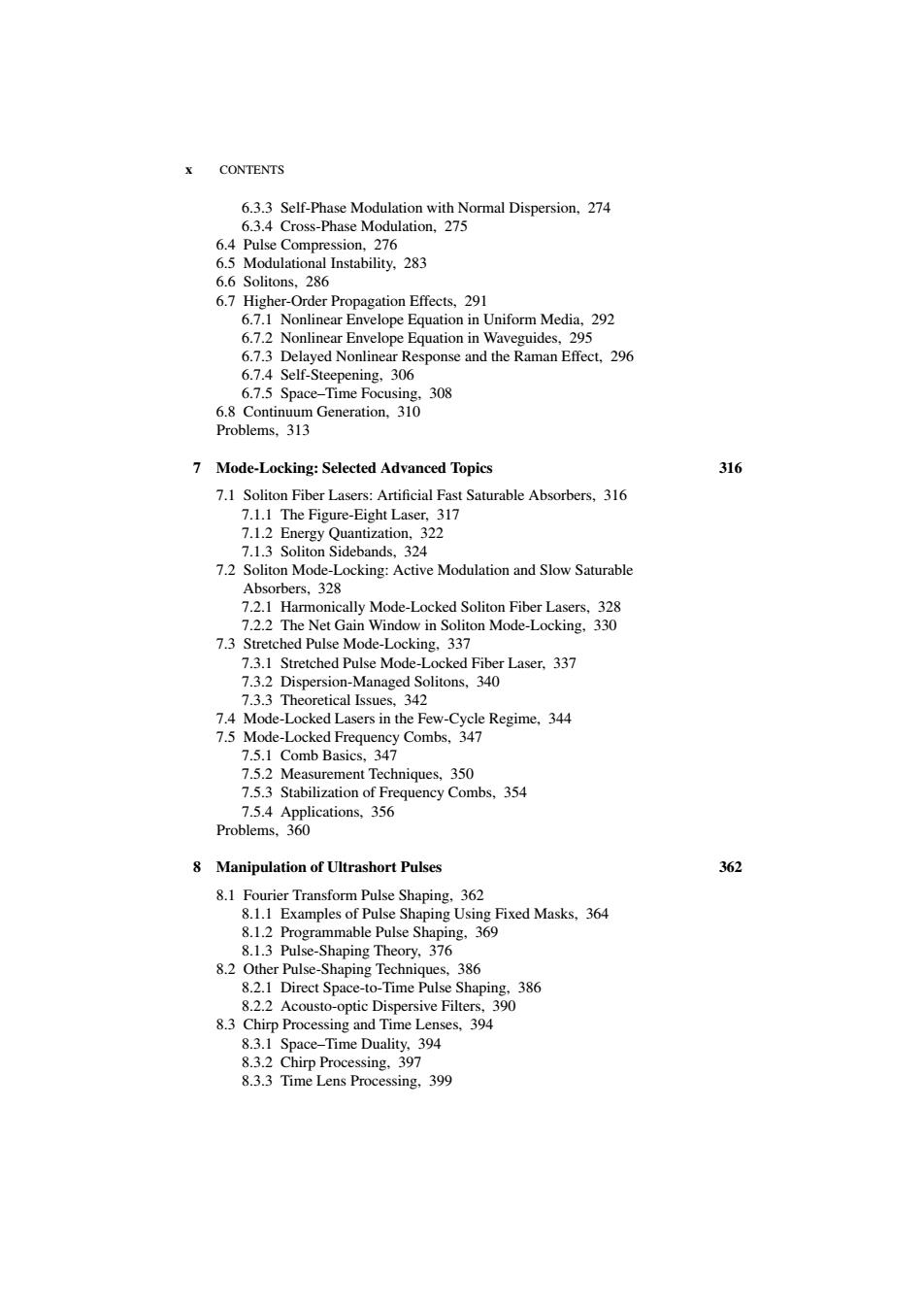
x CONTENTS 6.3.3 Self-Phase Modulation with Normal Dispersion,274 6.3.4 Cross-Phase Modulation,275 6.4 Pulse Compression,276 6.5 Modulational Instability,283 6.6 Solitons.286 6.7 Higher-Order Propagation Effects,291 6.7.1 Nonlinear Envelope Equation in Uniform Media,292 6.7.2 Nonlinear Envelope Equation in Waveguides,295 6.7.3 Delayed Nonlinear Response and the Raman Effect,296 6.7.4 Self-Steepening,306 6.7.5 Space-Time Focusing,308 6.8 Continuum Generation,310 Problems.313 7 Mode-Locking:Selected Advanced Topics 316 7.1 Soliton Fiber Lasers:Artificial Fast Saturable Absorbers,316 7.1.1 The Figure-Eight Laser,317 7.1.2 Energy Quantization,322 7.1.3 Soliton Sidebands,324 7.2 Soliton Mode-Locking:Active Modulation and Slow Saturable Absorbers,328 7.2.1 Harmonically Mode-Locked Soliton Fiber Lasers,328 7.2.2 The Net Gain Window in Soliton Mode-Locking.330 7.3 Stretched Pulse Mode-Locking.337 7.3.1 Stretched Pulse Mode-Locked Fiber Laser.337 7.3.2 Dispersion-Managed Solitons,340 7.3.3 Theoretical Issues.342 7.4 Mode-Locked Lasers in the Few-Cycle Regime,344 7.5 Mode-Locked Frequency Combs,347 7.5.1 Comb Basics.347 7.5.2 Measurement Techniques,350 7.5.3 Stabilization of Frequency Combs,354 7.5.4 Applications,356 Problems,360 8 Manipulation of Ultrashort Pulses 362 8.1 Fourier Transform Pulse Shaping,362 8.1.1 Examples of Pulse Shaping Using Fixed Masks,364 8.1.2 Programmable Pulse Shaping,369 8.1.3 Pulse-Shaping Theory,376 8.2 Other Pulse-Shaping Techniques,386 8.2.1 Direct Space-to-Time Pulse Shaping,386 8.2.2 Acousto-optic Dispersive Filters.390 8.3 Chirp Processing and Time Lenses,394 8.3.1 Space-Time Duality,394 8.3.2 Chirp Processing.397 8.3.3 Time Lens Processing,399
x CONTENTS 6.3.3 Self-Phase Modulation with Normal Dispersion, 274 6.3.4 Cross-Phase Modulation, 275 6.4 Pulse Compression, 276 6.5 Modulational Instability, 283 6.6 Solitons, 286 6.7 Higher-Order Propagation Effects, 291 6.7.1 Nonlinear Envelope Equation in Uniform Media, 292 6.7.2 Nonlinear Envelope Equation in Waveguides, 295 6.7.3 Delayed Nonlinear Response and the Raman Effect, 296 6.7.4 Self-Steepening, 306 6.7.5 Space–Time Focusing, 308 6.8 Continuum Generation, 310 Problems, 313 7 Mode-Locking: Selected Advanced Topics 316 7.1 Soliton Fiber Lasers: Artificial Fast Saturable Absorbers, 316 7.1.1 The Figure-Eight Laser, 317 7.1.2 Energy Quantization, 322 7.1.3 Soliton Sidebands, 324 7.2 Soliton Mode-Locking: Active Modulation and Slow Saturable Absorbers, 328 7.2.1 Harmonically Mode-Locked Soliton Fiber Lasers, 328 7.2.2 The Net Gain Window in Soliton Mode-Locking, 330 7.3 Stretched Pulse Mode-Locking, 337 7.3.1 Stretched Pulse Mode-Locked Fiber Laser, 337 7.3.2 Dispersion-Managed Solitons, 340 7.3.3 Theoretical Issues, 342 7.4 Mode-Locked Lasers in the Few-Cycle Regime, 344 7.5 Mode-Locked Frequency Combs, 347 7.5.1 Comb Basics, 347 7.5.2 Measurement Techniques, 350 7.5.3 Stabilization of Frequency Combs, 354 7.5.4 Applications, 356 Problems, 360 8 Manipulation of Ultrashort Pulses 362 8.1 Fourier Transform Pulse Shaping, 362 8.1.1 Examples of Pulse Shaping Using Fixed Masks, 364 8.1.2 Programmable Pulse Shaping, 369 8.1.3 Pulse-Shaping Theory, 376 8.2 Other Pulse-Shaping Techniques, 386 8.2.1 Direct Space-to-Time Pulse Shaping, 386 8.2.2 Acousto-optic Dispersive Filters, 390 8.3 Chirp Processing and Time Lenses, 394 8.3.1 Space–Time Duality, 394 8.3.2 Chirp Processing, 397 8.3.3 Time Lens Processing, 399